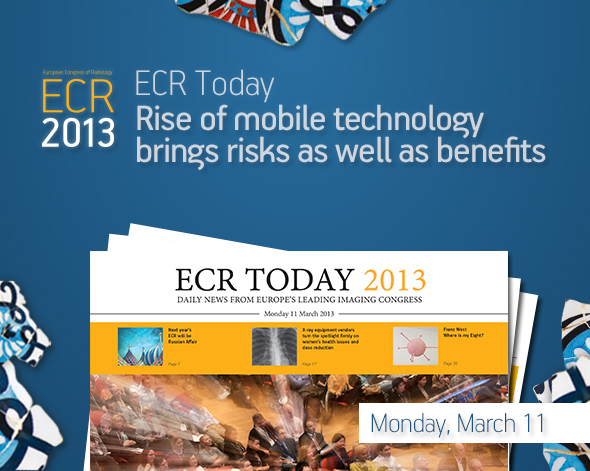Rise of mobile technology brings risks as well as benefits
Watch this session on ECR Live: Monday, March 11, 16:00–17:30, Room F1
Tweet #ECR2013F1 #SF19
Tablet computers can be a surprisingly divisive subject. The passion with which some people argue the relative merits of competing devices and operating systems can be almost frightening. In the field of medicine, however, there appears to be very little argument about the top product, with professionals from many disciplines enthusiastically embracing the iPad as a tool for research, education and general communication. Instead the most important debate is focused elsewhere, on matters of data security and patient privacy.
As mobile technology spreads throughout the hospital, data naturally follows, and it is slowly falling into the hands of an increasingly broad spectrum of people. Radi-ologists and clinicians therefore need to be aware, not just of the many mobile applications and resources that can potentially aid their work, but of the associated risks and best practices concerning the use of tablet technology.

Dr. Erik Ranschaert (left – pictured here with Dr. Jan Schillebeeckx) from ‘s-Hertogenbosch, the Netherlands, will speak on mobile telera-diology with tablet computers in this Special Focus Session
“When it comes to the iPad, it’s the same for radiologists as it is for everyone else; everyone wants to use them,” said Dr. Erik Ranschaert, staff radiologist at the Jeroen Bosch Ziekenhuis teaching hospital in ‘s-Hertogenbosch, the Netherlands. “I use mine to keep up with literature and store important articles, to take notes and integrate pictures, and I also use it during image interpretations, when I need to look things up like literature or anatomy. There are a vast number of tools available for radiologists on the iPad and I think curiosity among radiologists, of how to make the best of them, is very high.”
Ranschaert will speak during today’s Special Focus Session ‘Tablets in radiology: friend or foe’, which aims to provide an overview of the current status of tablet tech-nology and a discussion on the pros and cons of the use of tablets in radiology. Talks will touch on all aspects of how tablets can assist working radiologists, residents, and students, including a review of radiological resources and a close look at DICOM viewers, but the downsides will not be overlooked.
“It’s a fact that the use of the iPad is increasing exponentially among medical doctors, not only radiologists, but there are still a lot of issues that need to be ex-amined. For example, when you’re sending images to mobile applications, how safe is it and how can you guarantee patient confidentiality is not lost? The range of clinicians who make use of and require access to images is increasing, so images are on the move more frequently and this is all due to the availability of these new technologies,” said Ranschaert.
Cardiologists, emergency doctors and surgeons, among others, are finding more and more uses for iPads, from showing images to patients during bedside consul-tations, to using them for orientation in surgery; and patients themselves are also gradually taking possession of their own images in digital formats. With data flow-ing more freely, and mobile applications beginning to appear that offer patients services like second opinions, clarification of findings, and report explanations, the question of how to safeguard patient confidentiality is becoming all the more pressing.
“Especially in hospitals, it’s becoming more and more common to have a general hospital policy that before doctors start using mobile applications or tablets, they should sign an agreement to guarantee privacy and security. Images should be available everywhere because they are very important; they can help to improve qual-ity, avoid mistakes, and generally improve services to patients, but I think perhaps not enough hospitals are aware of the safety and security issues raised by mobile technology,” said Ranschaert.
A report last year by the Poneman Institute, an American research centre focusing on privacy, data protection and information security, suggests that although em-ployees in approximately 81 percent of healthcare organisations “are using mobile devices to collect, store and/or transmit some form of protected health information, 49 percent admit their organisations are not doing anything to protect these devices.” One concern is that mobile devices are easily lost, and if confidential patient data is stored on board or within applications, it can potentially be accessed by anyone. Ideas to deal with such risks include management from a central location, so that a stray device can be locked down or even wiped at a certain distance.
Such problems may be accentuated by a tendency towards the ‘bring your own device’ (BYOD) model, in which employees use their personal devices for work, entail-ing an additional set of security and safety issues. For instance, unless specific security measures are put in place, when personally owned devices connect with a hospital network, data shared between them is often not encrypted, leaving it vulnerable to hacking. BYOD also requires additional investment, not just in IT infrastruc-ture, but in training and manpower, to apply and monitor appropriate lines of defence against data breaches.
However mobile technology develops, these issues are clearly in need of greater consideration, so that when guidelines are created in future, more attention is paid to the very specific safety aspects of mobile ‘teleradiology’ inside and outside the hospital. Aside from the risks, all medical staff using mobile technology need to be familiar with the consequences of data breaches, which as well as the violation of patient privacy, may extend to fines, lawsuits or negative publicity. As with any other kind of security issues, until firm recommendations or directives are in place, the key to heading off potential problems is awareness.
“These things need to be discussed and brought to the attention of everyone, and that’s one of the many reasons for a session like this one. People have to start thinking about it; they have to not only consider the advantages but also the disadvantages, because there is an initial enthusiasm about these mobile ap-plications and devices, which is fantastic, but there is also a downside and we have to take that into account,” noted Ranschaert.
Special Focus Session
Monday, March 11, 16:00–17:30, Room F1
SF 19 – Tablet computers in radiology: friend or foe?
• Chairman’s Introduction
E. Neri; Pisa/IT
• Tablet computers: a technical overview
J. Fernandez-Bayó; Sabadell/ES
• Radiological features of the tablet computer
P. Sacco1; Siena/IT, and L. Faggioni; Pisa/IT
• Reading DICOM images on the tablet
O. Ratib; Geneva/CH
• Mobile teleradiology with tablet computers: a critical appraisal
E.R. Ranschaert; ‘s-Hertogenbosch/NL
• Panel discussion: Are we ready and confident enough to use tablet computers in clinical practice? How and when?



BOYD is wrong…it should be BYOD
Fixed. Thanks for pointing it out!